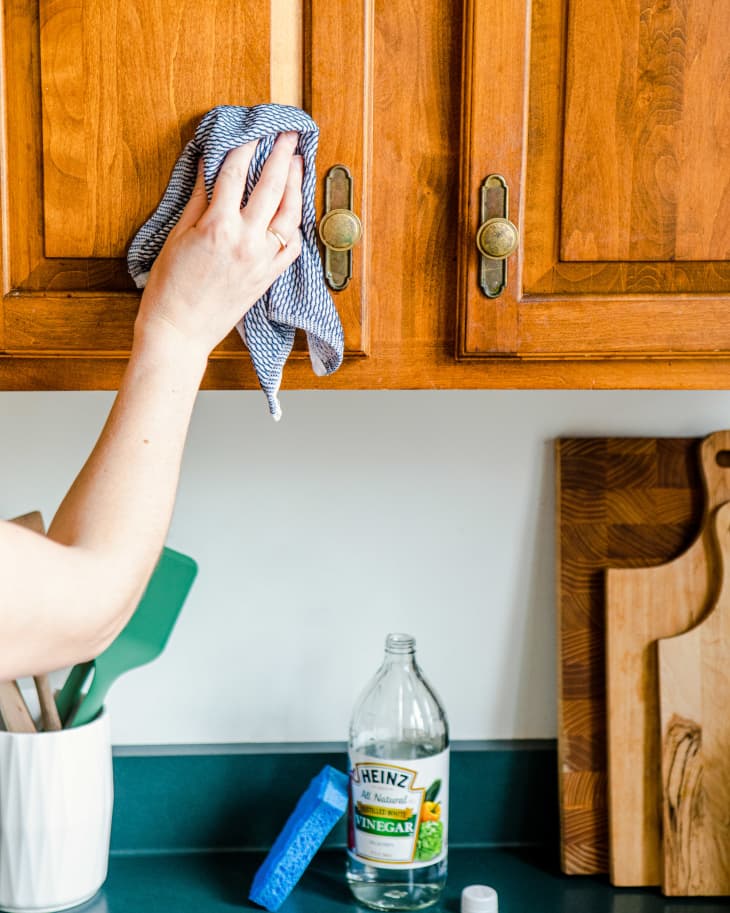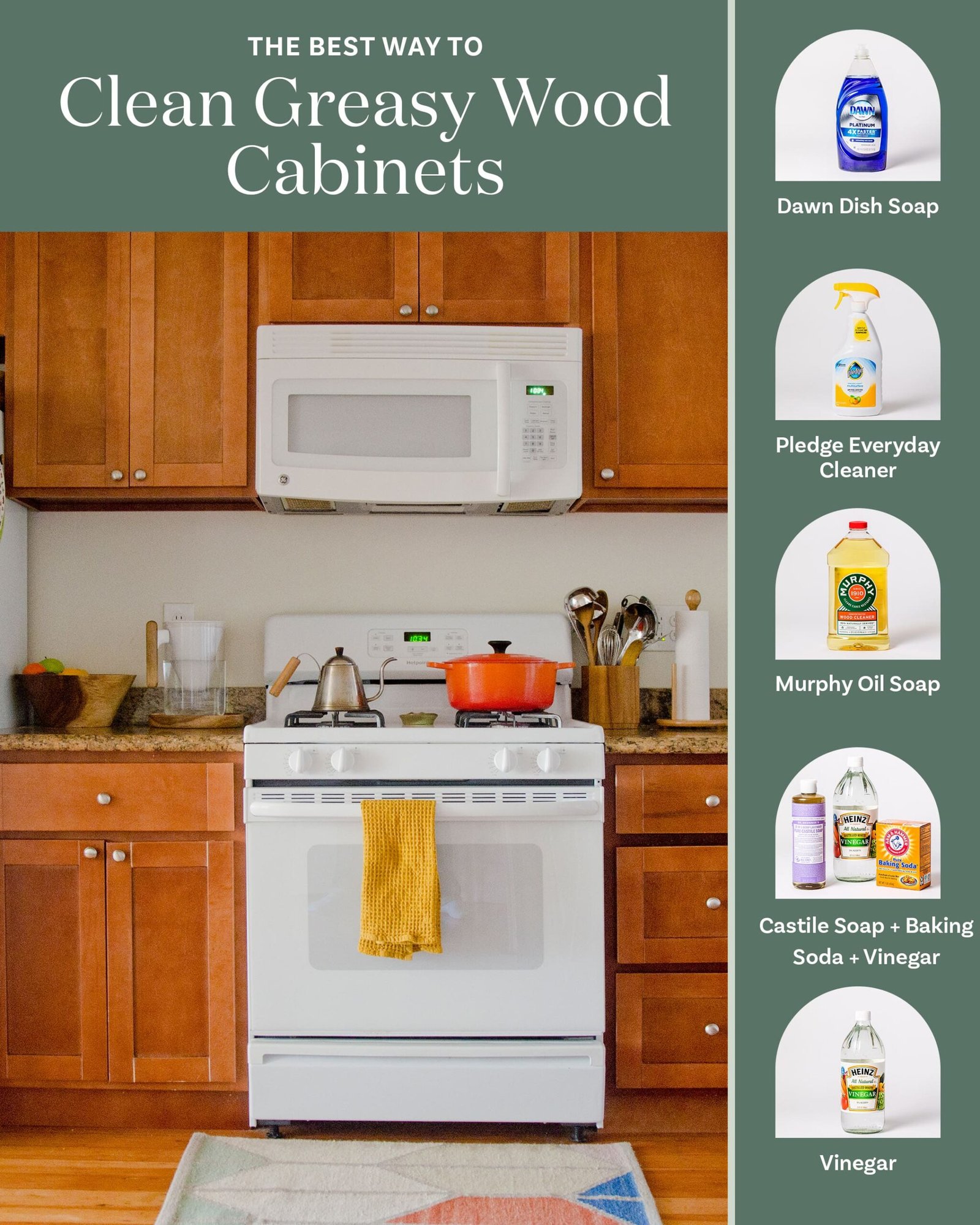To clean kitchen cabinets, use a gentle cleanser and a soft cloth. Wipe down surfaces and dry thoroughly.
Kitchen cabinets can accumulate grease, grime, and food particles over time. Regular cleaning keeps them looking fresh and extends their lifespan. Use a gentle cleanser to avoid damaging the finish. A soft cloth or sponge helps in removing dirt effectively.
Pay special attention to handles and corners where dirt tends to build up. After cleaning, dry the surfaces thoroughly to prevent moisture damage. Consistent care not only maintains their appearance but also ensures a hygienic cooking environment. This simple routine can make a significant difference in the overall look and feel of your kitchen.

Credit: m.youtube.com
Table of Contents
TogglePreparation Steps
Cleaning kitchen cabinets can be a daunting task, but with proper preparation, it becomes manageable. Follow these preparation steps to ensure your cabinets shine and stay in top condition.
Gather Supplies
Before starting, collect all necessary supplies. Having everything in one place saves time.
- Cleaning solutions: Choose mild detergents or homemade solutions.
- Microfiber cloths: Soft and lint-free for better cleaning.
- Sponges: Non-abrasive sponges work best.
- Bucket: For mixing and storing cleaning solution.
- Old toothbrush: Useful for scrubbing tight corners.
- Vacuum with brush attachment: For removing loose debris.
Empty Cabinets
Before you start cleaning, empty your cabinets. This makes cleaning easier and more effective.
- Remove all items: Take out dishes, utensils, and food items.
- Sort items: Check for expired or unused items. Discard if necessary.
- Place items in boxes: Use boxes to temporarily store items. Label each box for easy organization.
Once empty, you can proceed to clean the cabinets thoroughly.
Choosing The Right Cleaner
Cleaning kitchen cabinets can be a daunting task. The key to success lies in choosing the right cleaner. Using the appropriate cleaner will ensure your cabinets look fresh and last longer. Whether you prefer commercial cleaners or homemade solutions, selecting the right product is essential.
Commercial Cleaners
Commercial cleaners are readily available and easy to use. They are specifically designed to tackle tough grease and grime. Here are some popular commercial cleaners you might find useful:
| Brand | Type | Features |
|---|---|---|
| Simple Green | All-Purpose | Non-toxic, biodegradable |
| Murphy Oil Soap | Wood Cleaner | Natural ingredients, gentle on wood |
| Krud Kutter | Degreaser | Removes tough grease, no harsh fumes |
Always read the label before using any commercial cleaner. Ensure it is safe for your cabinet material.
Homemade Solutions
Homemade solutions are eco-friendly and budget-friendly. You can make effective cleaners with common household items. Here are some simple recipes:
- Vinegar and Water: Mix equal parts of white vinegar and water. Use this solution for general cleaning.
- Baking Soda and Water: Combine baking soda with water to form a paste. This paste works well for stubborn stains.
- Dish Soap and Warm Water: Add a few drops of dish soap to warm water. This is great for removing grease.
Always test any homemade solution on a small area first. This ensures it doesn’t damage your cabinet finish.
Cleaning Wooden Cabinets
Wooden cabinets add warmth and elegance to any kitchen. Keeping them clean ensures they last long and look beautiful. It’s important to use the right methods to avoid damage. Here, we’ll guide you through the steps for cleaning wooden cabinets effectively.
Dust Removal
Dusting is the first step in cleaning wooden cabinets. Dust can accumulate quickly and make the cabinets look dull. Use a soft microfiber cloth to gently wipe the surfaces. Pay attention to corners and edges where dust gathers.
For tough dust, use a vacuum with a brush attachment. This helps remove dust from intricate designs and grooves. Ensure you use the vacuum on a low setting to avoid scratching the wood.
Deep Cleaning
Deep cleaning wooden cabinets is essential for removing grease and grime. Use a mixture of warm water and mild dish soap. Avoid harsh chemicals as they can damage the wood. Mix a few drops of dish soap in a bowl of warm water.
Dip a soft cloth in the solution and wring it out. Wipe down the cabinets thoroughly. For stubborn grease, use a soft-bristled brush. Scrub gently to avoid scratching the surface.
After cleaning, rinse the cabinets with a damp cloth. Ensure all soap residue is removed. Dry the cabinets with a clean towel to prevent water damage.
| Cleaning Task | Tools Needed | Tips |
|---|---|---|
| Dust Removal | Microfiber cloth, vacuum with brush attachment | Use a low setting on the vacuum |
| Deep Cleaning | Warm water, mild dish soap, soft cloth, soft-bristled brush | Rinse and dry the cabinets thoroughly |
Regular cleaning keeps your wooden cabinets in top condition. Follow these steps to maintain their beauty and longevity. Happy cleaning!
Cleaning Laminate Cabinets
Laminate cabinets bring a sleek and modern look to your kitchen. They are durable and easy to maintain. With the right cleaning techniques, you can keep them looking new and shiny. Below are some tips for cleaning laminate cabinets effectively.
Gentle Wiping
Begin by using a soft microfiber cloth. Dampen it with warm water. Avoid using harsh chemicals. They can damage the laminate surface. Wipe down the cabinets gently. Use circular motions to remove dirt and grime. Don’t forget to clean the edges and handles.
If you face stubborn spots, add a drop of mild dish soap. Mix it with water. Then, wipe the area again. Rinse the cloth and wipe off any soap residue. Dry the cabinets with a clean, dry cloth to prevent water spots.
Stain Removal
Stains can be a bit tricky on laminate cabinets. For light stains, use a baking soda paste. Mix baking soda with a little water. Apply the paste to the stain. Let it sit for a few minutes. Then, gently scrub with a soft sponge.
For tougher stains, use white vinegar. Mix equal parts of white vinegar and water. Apply the solution to the stain. Let it sit for a few minutes. Wipe it off with a clean cloth.
Use a table to summarize the cleaning methods:
| Cleaning Task | Method |
|---|---|
| Gentle Wiping | Microfiber cloth, warm water, mild dish soap |
| Light Stain Removal | Baking soda paste |
| Tough Stain Removal | White vinegar solution |
Remember to always dry the cabinets after cleaning. This prevents water damage and keeps your kitchen cabinets looking pristine.
Cleaning Glass Cabinets
Glass cabinets add a touch of elegance to any kitchen. They showcase your glassware and dishes beautifully. Keeping them clean enhances their appearance and ensures they remain a highlight in your kitchen.
Glass Cleaner Application
Start by choosing a high-quality glass cleaner. Avoid products with ammonia, which can leave streaks. You can also make a DIY cleaner using equal parts water and vinegar.
- Spray the cleaner on the glass surface.
- Use a microfiber cloth to wipe the glass.
- Wipe in a circular motion for the best results.
- Ensure all areas are covered, including corners.
Repeat this process until the glass is spotless. If you see streaks, use a dry microfiber cloth to buff them out.
Polishing Tips
Once the glass is clean, you can polish it. Polishing gives the glass a shiny finish. This step also helps remove any remaining streaks.
- Use a dry, clean microfiber cloth.
- Polish the glass in small, circular motions.
- Focus on one section at a time.
- Check for streaks and spots as you go.
For extra shine, you can use a small amount of rubbing alcohol. Apply it to the cloth, not directly on the glass. Polish gently to avoid scratches.
Maintaining clean glass cabinets keeps your kitchen looking fresh and bright. Regular cleaning and polishing make a big difference.

Credit: www.thekitchn.com
Tackling Grease And Grime
Kitchen cabinets can collect a lot of grease and grime. Cleaning them can feel like a big job, but it doesn’t have to be. With the right methods, you can make your cabinets look new. Let’s dive into the best ways to tackle grease and grime.
Degreaser Use
A good degreaser can make a world of difference. Start by choosing a non-toxic degreaser that’s safe for kitchen use. Spray the degreaser directly onto the greasy spots. Let it sit for a few minutes to break down the grease. Use a soft cloth or sponge to wipe away the grime. For stubborn spots, you might need to scrub gently. Always rinse with water to remove any leftover residue.
| Step | Action |
|---|---|
| 1 | Choose a non-toxic degreaser |
| 2 | Spray directly on greasy spots |
| 3 | Let it sit for a few minutes |
| 4 | Wipe with a soft cloth |
| 5 | Scrub stubborn spots gently |
| 6 | Rinse with water |
Preventing Build-up
Preventing grease and grime build-up is key. Regularly wiping down cabinets can help. Use a mild soap and water solution for daily cleaning. Dry the cabinets thoroughly to prevent water damage. Installing a range hood can also reduce grease build-up. The hood will capture grease particles from cooking. Ensure the filters are clean and working well.
- Wipe cabinets regularly with mild soap and water.
- Dry cabinets thoroughly after cleaning.
- Install a range hood to capture grease particles.
- Keep range hood filters clean and functional.
With these tips, your kitchen cabinets will stay clean and grease-free. Regular maintenance is the secret to easy cleaning. Keep up with it, and your kitchen will always look its best.
Finishing Touches
After you’ve scrubbed and rinsed your kitchen cabinets, it’s time for the Finishing Touches. These final steps will ensure your cabinets look their best. Follow these easy methods to dry and polish your cabinets, making them shine like new.
Drying Techniques
Proper drying prevents water damage and streaks on your cabinets. Use these methods to ensure a perfect finish:
- Microfiber Cloth: Gently wipe each cabinet with a clean, dry microfiber cloth. This material absorbs moisture effectively.
- Air Drying: Leave cabinet doors open to let them air dry. This is especially useful for hard-to-reach corners.
- Paper Towels: For quick drying, use paper towels. They are great for absorbing excess water.
Cabinet Polishing
Polishing your cabinets keeps them looking fresh and new. Follow these simple steps:
- Select a Polish: Choose a polish suitable for your cabinet material. Wood, laminate, and painted cabinets may require different products.
- Apply Polish: Put a small amount of polish on a soft cloth. Rub gently in a circular motion.
- Buff the Surface: Use a clean cloth to buff the cabinets. This removes excess polish and brings out the shine.
Here’s a quick reference table for polish types and materials:
| Cabinet Material | Recommended Polish |
|---|---|
| Wood | Wood-specific polish |
| Laminate | All-purpose cleaner |
| Painted | Gentle, non-abrasive polish |
These Finishing Touches are essential for maintaining the beauty and longevity of your kitchen cabinets. Dry and polish them regularly to keep your kitchen looking sparkling clean.
:max_bytes(150000):strip_icc()/steps-to-clean-kitchen-cabinets-1900630-final-5bbcde064cedfd0026eeec24.png)
Credit: www.thespruce.com
Maintenance Tips
Keeping kitchen cabinets clean can be easy. Follow these maintenance tips. You’ll extend the life of your cabinets and keep them looking new.
Regular Cleaning Routine
Establish a regular cleaning routine. Dust your cabinets weekly. Use a soft cloth or a feather duster. Remove any spills immediately. This prevents stains and sticky residue.
- Wipe doors and handles weekly.
- Use a mild cleaner and warm water.
- Dry with a soft towel to avoid water spots.
For deep cleaning, mix a few drops of dish soap with warm water. Use this solution to scrub any grime. Rinse and dry thoroughly.
Protective Measures
Use protective measures to keep your cabinets safe. Install cabinet liners. These liners protect against spills and crumbs.
Apply a protective wax or polish. This helps to seal the wood. It also prevents damage from moisture.
| Protective Measure | Benefit |
|---|---|
| Cabinet Liners | Protects from spills |
| Wax or Polish | Seals wood, prevents moisture damage |
Use shelf risers to organize and protect items inside. Shelf risers keep heavy pots from scratching surfaces.
Place mats under appliances. Mats can catch drips and spills. They are easy to clean and replace.
Frequently Asked Questions
How Often Should I Clean Kitchen Cabinets?
Clean kitchen cabinets every two weeks to prevent grime buildup.
What Is The Best Cleaner For Cabinets?
Mild dish soap and warm water work best for most cabinets.
Can I Use Vinegar On Kitchen Cabinets?
Yes, vinegar mixed with water effectively cleans and disinfects cabinets.
How Do I Remove Grease From Cabinets?
Use a mixture of baking soda and water to scrub away grease.
Are There Natural Cleaners For Kitchen Cabinets?
Yes, use vinegar, baking soda, or lemon juice for natural cleaning solutions.
Should I Remove Cabinet Doors To Clean Them?
Not necessary, but removing doors can make cleaning easier and more thorough.
How Do I Clean Cabinet Handles?
Wipe handles with a cloth dipped in soapy water, then dry.
What To Avoid When Cleaning Cabinets?
Avoid harsh chemicals and abrasive sponges to prevent damage.
Can I Use A Steam Cleaner On Cabinets?
Yes, but use it on low settings to avoid warping or damaging the finish.
How Do I Maintain The Cabinet Finish?
Regularly dust and clean with a soft cloth to preserve the finish.
Conclusion
Keeping your kitchen cabinets clean enhances your home’s appearance and hygiene. Use gentle cleaners and regular maintenance for best results. Organized cabinets not only look good but also make cooking more enjoyable. Follow these simple steps to ensure your kitchen remains fresh and inviting.
Happy cleaning!


